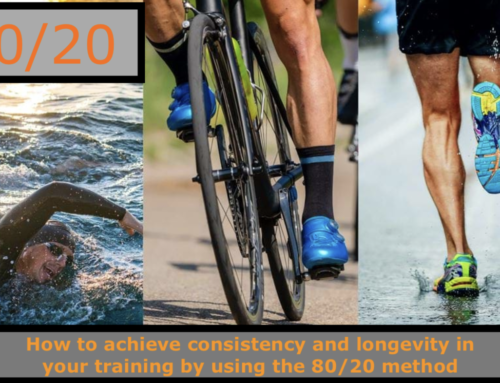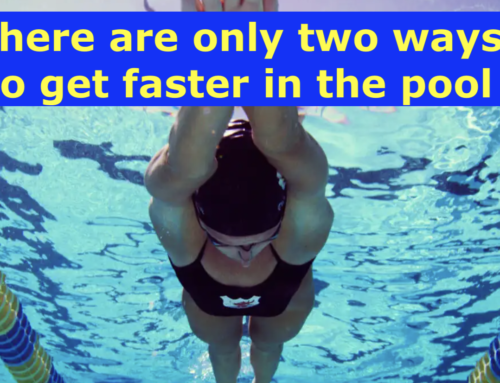As we emerged from lockdown I started writing swim sets with 25 & 50m reps on the basis that short intervals could lead to big improvements in your swim fitness. Let’s talk about the reasoning behind this.
What happens after 4-5 months of no pool time?
- Lack of muscular endurance in the shoulders and upper back
- Traditionally poor technique for the average triathlete
- The psychological impact of swimming long reps in general, and it’s now exacerbated by lack of swim fitness
- A requirement to develop fitness quickly and efficiently, while avoiding injury
What are some key swim requirements for a triathlete?
- Generally, complete race distances of 1500m – 3800m (20 minutes to – 2hrs)
- Swim consistently to build muscular endurance and fatigue resistance
- Avoid swimming-related injury
- Keep intensity at a low to moderate level (Z2?) for the majority of the time to help build mitochondria
- Do this as efficiently as possible, thereby saving energy for the bike and run sections
- Make the cut-off
As a coach, ideally, I would like swimmers to develop a good technique and then be able to maintain that for as much of the session as possible. This requires good muscular endurance in the upper back and shoulders, along with mindfulness during the session. If fatigue causes both to deteriorate then the results are poor movement patterns and a harder session. Why? Because poor technique leads to less distance per stroke, more strokes per length, and more effort required to hit the same times.
Let’s talk about shorter swim sets
So, how do short intervals mean big improvements in your swim fitness? Sticking to 25 or 50m reps can keep the fatigue down, thus enabling the individual to focus on good technique, and to maintain the pace with less effort. This might be a more acceptable approach for many swimmers for the bulk of their swim workouts going forward. Reps of >400m distance can seem so daunting, and all but the best swimmers fade drastically in pace after the first 200m.
Here are some of the benefits that you might experience when you break your swim sets into shorter reps:
- Less daunting psychologically
- Better fatigue resistance
- Ability to maintain a set pace for longer
How might you introduce this approach to your own training plan or that of your squad if you are a coach?
- Plan to keep all conditioning reps to a maximum of 25 or 50m. You can swim for longer in warm-up or cool-down.
- Leave the longer reps (i..e >100m) to your open water swim where you can simulate some of the race-specific requirements.
I don’t believe that it is necessary to swim the race distance non-stop in the lead-up to the race, as long as you’re covering the race distance or more during your sessions. However, if you feel that you do need this confidence boost, then by all means test yourself just once before the race. If you can’t do it in the open water because you don’t have access, then non-stop in the pool will work.
Alternatively, you can try this option using ultrashort reps:
Say you’re aiming for a 70.3 event and you have a 25m pool (1900 meter event swim divided by 25-meter pool equals 76 lengths). If you want to know that you can swim 1900m in 60 minutes (1h10m is usually the cut-off), your target is to swim every 25m length, plus recovery time, starting every 45 seconds.
Sample Swim Set
- 8 x 25m swim +10 second recovery
- 8 x 25m pull + 10 second recovery
- 8 x 25m as drill of your choice on the odd length, and swim on the even length + 10 second recovery
- 8 x 25m build (start slow, finish fast) + 10 second recovery
- 20 x 25m (hold times, aim for 8 out of 10 effort across the whole set + 10 second recovery after each length
- 20 x 25m (hold same times as set #1, aim for 8/10 effort across the whole set) + 10 second recovery
- 8 x 25m cool down as 25 breaststroke/25 backstroke
Once you’ve completed this set you should have confidence that you can complete the distance and beat the cut-off. By all means, repeat this set every 2-3 weeks as your fitness builds. Of course, if you already know that you can make the cut-off and you have a faster target, adjust the turnaround times for each 25m. Remember, short intervals really can mean big improvements to your swim fitness!
Summary
You may wonder, “If I do very short reps, how will I build my mental strength to cope with the monotony of long races?” I say, “Try swimming 160 x 25 first and then let me know how you deal with that monotony”. And yes, you need a different mental approach from a training session to a race, but both develop fortitude.
Whether you swim a set of 4 x 1k or 160 x 25m the end result is the same, you cover 4k. You’ll find that your pace will be more stable during the 25m session, and you’ll feel less fatigued afterward. I’d love to hear your thoughts about this approach!
I have created a “Return to Swim” programme based on this philosophy. To obtain your FREE copy, please go HERE. Scroll down and you’ll see two options for Return to Swimming, 2 per week or 3 per week.
Lastly, remember that consistency is key. Progress may take time as you return to swimming, but it will come. To read more about consistency, please check out this article: https://www.simonward.co.uk/2020/09/26/consistency-is-the-best-way-to-improve-your-long-term-fitness/
To find out more about Simon’s coaching services, please click here. To purchase Simon’s e-book, How to be a High Performance Human, please click here.







Leave A Comment